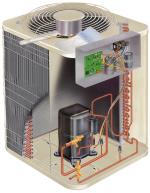
Please click above on this sponsor's banner to see their unique products.
Their sponsorship allows me to continue to provide my web site for you.
Thank you for your support and for visiting my web site.
Search engine visitors - click here to access entire "$ensible Home" web site

Please click above on this sponsor's banner to see their unique products.
Their sponsorship allows me to continue to provide my web site for you.
Thank you for your support and for visiting my web site.
Click here to see a descriptive illustration showing several types of new central air conditioner systems.
Dear Jim: I am ready for a new, quieter and more efficient central air conditioner. My old one doesn't always keep the house comfortable. It feels clammy in here sometimes. What should I look for in new models? - Ronnie L.

A: You have picked a good year to replace your central air conditioner. There have been some significant recent changes and improvements in the most efficient and comfortable models. Also, sound levels have been seriously addressed and they are much quieter, indoors and outdoors.
This year, the efficiencies (SEER) have skyrocketed up to 24 and the comfort level is improved. If your existing air conditioner is older than 10 years, installing a new one will cut your cooling electric bills by more than 50 percent. Depending on your climate, it can provide a quick payback.
These high-efficiency models also provide the best comfort particularly during the milder weather of early and late summer. This is when you often sense that clammy feeling. The indoor air gets cool enough, but the air conditioner has not run long enough to also adequately dehumidify the air.
Using a modulating rotary or a two-stage compressor and a multispeed condenser fan, these models fine tune the cooling output to the cooling needs of your home. During mild weather, they operate in the slow, super-efficient stage with reduced cooling output. In this slow stage, they run longer and dehumidify better.
There are several designs of two-stage compressors. Some use a two-piston compressor. When it rotates in one direction, only one piston moves. When the rotation reverses, both pistons move to double the cooling. Another design uses a two-speed compressor. Some models use two small compressors. These run on only one compressor except for very hot days with high cooling needs.
The newest and most efficient design is a two-stage scroll compressor. A scroll compressor has very few moving parts and operates quietly. This new two-stage scroll uses ozone-friendly R410A refrigerant. Compressors using old freon R-22 were phased out of production by law in 2010.
Models that use R410A instead of freon tend to operate quieter. R410A requires higher operating pressures, so the tubing and materials must be made stronger. This changes the sound frequency making it is less annoying. Many other sound-deadening design changes are also now used.
Whether you choose a super-efficient two-stage or a lower-priced one-stage model, consider replacing the indoor air handler (furnace) with one using a variable-speed blower. This will increase the year-round (heating too) efficiency and comfort level with much less indoor noise. Also install a new compatible thermostat that controls cooling and humidity independently.
Instant Download Update Bulletin No. 921 - buyer's guide of the 18 most efficient modulating and two-stage central air conditioners listing type of refrigerant used, cooling output ranges, SEER efficiency ratings, type of compressor design, comfort features, warranties, tips for selecting a quality air-conditioning dealer, description and an illustration of how a scroll compressor works, savings/payback chart, and info on the new thermostats.
Dear Jim: I can get a great buy on some wide (1x5-inch) plastic decking material. I thought about using it instead of plywood sheets for my roof decking under the shingles. Will this be as strong as the plywood? - Bruce H.
A: I would not recommend using the plastic decking planks instead of 4x8-foot plywood sheets for the roof. With only five-inch-wide planks, there will be many spots where the shingle nails hit a joint between them.
Another problem is the strength required for a roof. The planks would not provide adequate rigidity. Also, a roof can reach 150 degrees in the hot summer sun. This would further diminish the strength of the plastic.